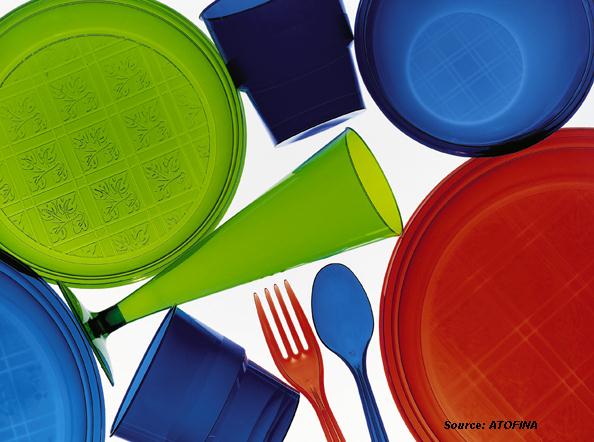Polystyrene
PS, or Polystyrene: a thermoplastic polymer which softens when heated and can be converted into semi-finished products like films and sheets, as well as a wide range of finished articles.

- History
- Properties
- Applications
- Processes
- Recycling
- Faq
History
Polystyrene was discovered in 1839 by Eduard Simon, an apothecary in Berlin. From storax, the resin of the Turkish sweetgum tree Liquidambar orientalis, he distilled an oily substance, a monomer that he named styrol. Several days later, Simon found that the styrol had thickened, presumably from oxidation, into a jelly he dubbed styrol oxide ("Styroloxyd"). By 1845 English chemist John Blyth and German chemist August Wilhelm von Hofmann showed that the same transformation of styrol took place in the absence of oxygen. They called their substance metastyrol. Analysis later showed that it was chemically identical to Styroloxyd. In 1866 Marcelin Berthelot correctly identified the formation of metastyrol/Styroloxyd from styrol as a polymerization process. About 80 years later it was realized that heating of styrol starts a chain reaction that produces macromolecules, following the thesis of German organic chemist Hermann Staudinger (1881–1965). This eventually led to the substance receiving its present name, polystyrene.
Properties
Polystyrene (PS) is a synthetic aromatic polymer made from the monomer styrene, a liquid petrochemical. Polystyrene can be rigid or foamed. General purpose polystyrene is clear, hard and brittle. It is a very inexpensive resin per unit weight. It is a rather poor barrier to oxygen and water vapor and has relatively low melting point. Polystyrene can be naturally transparent, but can be colored with colorants.
Applications
Packaging
Eggs and dairy products, meat, fish and poultry, cold drinks or carry-out meals. All these products are safely packed with polystyrene packaging materials; by doing so spoilage of foods is prevented. In the western world a combination of good packaging, refrigeration and transportation ensures that only two percent of food is lost through spoilage, compared with 50 percent in developing countries.
No matter what products you package, polystyrene has long been recognized as a versatile and cost-effective solution for rigid packaging and food service disposables.
Appliances
From refrigerators and air conditioners, to ovens and microwaves, from hand-held vacuum cleaners to blenders, polystyrene resins meet almost all end-product requirements. Polystyrene resins are safe and cost effective, with excellent appearance and functionality mainly due to easy-processing. Because of this almost 26 percent of the polystyrene demand is used in injection-molding, extrusion and thermoforming applications.
Consumer electronics
Polystyrene is used for housing for TV's and all kind of emerging trends in IT equipment where the critieria for use are combinations of function, form and aesthetics and a high performance/cost ratio. Polystyrene is the leading choice for media enclosures, cassette tape housing and clear jewel boxes to protect CD's and DVD's.
Construction
Polystyrene resins are among the most popular materials for building and construction applications, like Insulation foam, roofing, siding, panels, bath and shower units, lighting, plumbing fixtures. With their excellent price performance balance and good processability and other performance properties, polystyrene resins find use in these building products.
Medical
Bringing new and improved medical technologies to patients and physicians is a complex, regulated process. With excellent clarity and processability and outstanding post-sterilization aesthetics, polystyrene resins are used for a wide range of disposable medical applications, including tissue culture trays, test tubes, petri dishes, diagnostic components, and housing for test kits.
Other
As well as the traditional uses for polystyrene, a variety of consumer goods applications, including toys, electric lawn and garden equipment, kitchen and bath accessories and other durable goods are made from polystyrene. Polystyrene resins have an excellent cost/performance ratio, and in many cases, can be substituted for more costly polymers.
Processes
The building block - monomer - of polystyrene is styrene. The raw materials to make styrene are obtained from crude oil. A range of processes such as distillation, steam-cracking and dehydration are required to transform the crude oil into styrene. At the end polystyrene is produced by polymerising styrene. The final product is available in the form of pellets. In order to get the final articles polystyrene pellets are extruded, thermoformed or injection moulded. Extrusion is a process in which the pelletised polymer is melted and then forced continuously through a die to form an endless profile of polymer. Most of the time polystyrene is extruded into sheet. In a second step this sheet can be thermoformed into the final article. Applications of thermoformed articles include disposables such as cups and plates, meat and poultry trays, multiple and single-serving food containers in dairy, vending machine cups, trays for hospital and restaurant use. Injection moulding is a process by which polymer is melted and injected in a mould cavity, which after cooling down solidifies into the shape of the mould. Typical injection moulding applications are housing of televisions, jewel boxes for compact discs, toys and innumerable other uses.
Recycling
In general, polystyrene is not accepted in curbside collection recycling programs, and is not separated and recycled where it is accepted. Most polystyrene products are currently not recycled due to the lack of incentive to invest in the compactors and logistical systems required. Due to the low density of polystyrene foam, it is not economical to collect. However, if the waste material goes through an initial compaction process, the material changes density from typically 30 kg/m3 to 330 kg/m3 and becomes a recyclable commodity of high value for producers of recycled plastic pellets.
